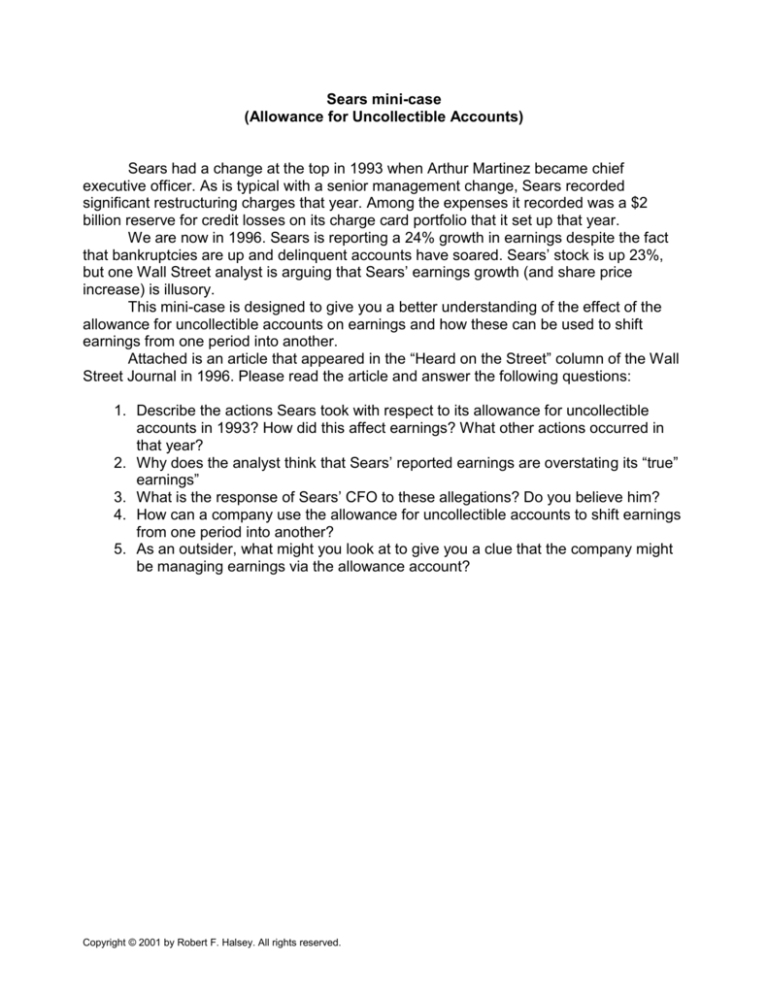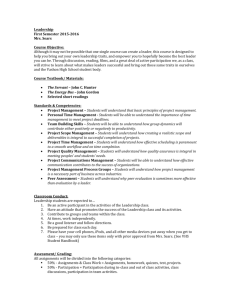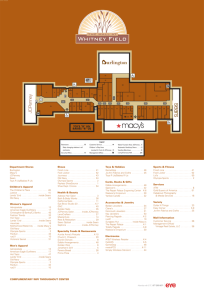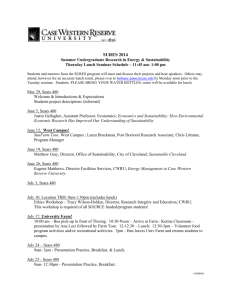
Sears mini-case
(Allowance for Uncollectible Accounts)
Sears had a change at the top in 1993 when Arthur Martinez became chief
executive officer. As is typical with a senior management change, Sears recorded
significant restructuring charges that year. Among the expenses it recorded was a $2
billion reserve for credit losses on its charge card portfolio that it set up that year.
We are now in 1996. Sears is reporting a 24% growth in earnings despite the fact
that bankruptcies are up and delinquent accounts have soared. Sears’ stock is up 23%,
but one Wall Street analyst is arguing that Sears’ earnings growth (and share price
increase) is illusory.
This mini-case is designed to give you a better understanding of the effect of the
allowance for uncollectible accounts on earnings and how these can be used to shift
earnings from one period into another.
Attached is an article that appeared in the “Heard on the Street” column of the Wall
Street Journal in 1996. Please read the article and answer the following questions:
1. Describe the actions Sears took with respect to its allowance for uncollectible
accounts in 1993? How did this affect earnings? What other actions occurred in
that year?
2. Why does the analyst think that Sears’ reported earnings are overstating its “true”
earnings”
3. What is the response of Sears’ CFO to these allegations? Do you believe him?
4. How can a company use the allowance for uncollectible accounts to shift earnings
from one period into another?
5. As an outsider, what might you look at to give you a clue that the company might
be managing earnings via the allowance account?
Copyright © 2001 by Robert F. Halsey. All rights reserved.
Dow Jones Interactive Publications Library
Heard on the Street
Sears 's Credit-Card Reserves
May Have Propped Up Earnings
By Susan Pulliam and Robert Berner
11/04/1996
The Wall Street Journal
(Copyright (c) 1996, Dow Jones & Company, Inc.)
Now for another peek at one of the tactics major corporations have at their
disposal to help produce smoothly rising earnings. This time, the spotlight is on Sears
Roebuck, the nation's second largest retailer and one of the best performing big retail
stocks for the last two years. This year, Sears shares are up 23%. But at least one Wall
Street analyst contends that Sears 's turnaround of late may not be as spectacular as it
looks. In a recent report, Sanford Bernstein analyst David Poneman argues that Sears 's
earnings growth this year of 24%, or $134 million, has been aided by a 1993 balancesheet maneuver that softens the impact of soaring levels of bad credit-card debt among its
50 million card holders. Wall Street got a wake-up call in the second quarter, when Sears
increased its provision for bad credit-card debt by $254 million, up 73% from the year
earlier. Then in the third quarter, it made another $286 million provision, a 53% increase.
Yet the retailer posted a 22% gain in third-quarter net. How so? " Sears is using its
superabundant balance sheet to smooth out its earnings," says Mr. Poneman. He says
Sears has a "quality-of-earnings issue."
Mr. Poneman is referring to a $2 billion reserve for credit losses that Sears set up in 1993,
half of it to cover potential credit-card losses, some resulting from the closing of its catalog
division. As it turned out, the reserve was higher than it needed to be. Three years later,
Sears still has a nearly $1 billion reserve on its balance sheet to cover credit-card losses.
That's nearly twice the size of reserves at most credit-card companies as a percentage of
receivables, for instance.
The credit-card reserve was part of a big bath that also included restructuring charges that
Sears took in 1993, shortly after Arthur Martinez became chief executive officer. Such
charges and reserves can be a big help for a new CEO who wants to generate a pattern
of improving results in future years. Mr. Poneman says the big addition to reserves
"moved income out of 1992 and 1993 and into 1995 and 1996." Although Sears 's
earnings were reduced by credit-card charge-offs of $239 million in the second quarter
and $272 million in the third quarter, Mr. Poneman says the retailer isn't replenishing the
reserve to reflect the growing problem.
Even though Sears 's credit-card delinquencies are 70% higher than they were at the end
of 1993, the size of the reserve remains the same as it was then. Why is that bad? From
Copyright © 2001 by Robert F. Halsey. All rights reserved.
the point of view of some investors and Mr. Poneman, the overly large reserve has
allowed Sears to prop up its earnings at a time when losses in its huge credit-card
business, which currently accounts for about 50% of its earnings, have been soaring.
Credit-card delinquencies stood at a total of $1.2 billion at the end of the third quarter, or
about 5% of its $25 billion portfolio. So far this year, Sears 's delinquencies have risen by
$420 million. "Considering that increased delinquencies exceed year-to-date increased
earnings, it could be argued that the increase in Sears 's year-to-date earnings has
depended entirely on its over-reserved condition entering 1996," Mr. Poneman wrote
clients in a recent report.
Allen Lacey, Sears 's chief financial officer, says in response to Mr. Poneman's assertions,
"When you make an actuarial estimate for something like credit-card debt, it can be higher
or lower than what you actually experience," But, he maintains, Sears has not used its
credit-card reserves as a way of avoiding earnings hiccups. Mr. Lacey says it's true that
Sears 's reserves as a percent of total receivables has dropped to about 4% from 5%
since 1993. But he said the company had over-reserved in the mistaken expectation that
closing the catalog would drive up catalog-customer credit-card defaults. Bernstein's Mr.
Poneman says Sears is operating well within the bounds of accepted accounting rules.
"Our point is that the properly stated profits from an accounting perspective have little to
do with the ongoing economics of the business," if reserves are being diluted relative to
future bad debts.
Sears 's credit-card woes may have their roots in 1993, when the retailing giant first began
allowing customers to use major charge cards other than Sears 's own card. In order to
avoid a drop in profits from its own credit-card division, Sears set out to sign up millions of
new cardholders. Sears sales clerks earned $2 for each new card account they helped
sign up. And potential holders were lured by low minimum monthly payments of as little as
2.4% of the balance. The strategy worked. Over 18 million new cardholders signed up,
nine million of whom began using their cards, running up balances that averaged $912
last year.
Mr. Lacey says any problems are under control. "Bankruptcies among holders are
flattening," he says. He concedes that delinquencies are still up from last year, but says
they have shown recent signs of moderating. But Mr. Poneman says delinquencies -accounts overdue more than two months -- rose by 5.3% in September, compared with a
5% increase in August. "Although Sears has great management, and the retail business
has great momentum, we believe that credit-quality problems inside Sears 's $25 billion
receivables portfolio are much greater than the market generally perceives." Before 1995,
Bernstein's Mr. Poneman says Sears maintained debt reserves at roughly 120% of
delinquent balances. Since then, he says, Sears has allowed the reserve to fall to 76% of
delinqencies. If Sears had maintained the reserve equal to delinquencies, its annual
earnings growth rate since 1992 would have been 15%, not 28% as reported.
Patrick McCormack, an analyst for Dean Witter Reynolds, says Mr. Poneman has a valid
point -- "they did borrow some earnings out of their reserves in 1996." But he says the real
question is what's going to happen in 1997, when Sears 's earnings could be seriously
Copyright © 2001 by Robert F. Halsey. All rights reserved.
hurt if personal bankruptcies get out of hand. He agrees with Sears that bankruptcies have
stabilized and should be manageable. Thomas Tashjian, an analyst for Montgomery
Securities, says working down the reserve is a smart move because it permits Sears to go
after new credit-card customers aggressively when competitors with lower reserves are
pulling back. Not surprisingly, Mr. Poneman doesn't think Sears stock will continue to beat
the market. He expects Sears to earn $3.10 per share in 1996. Half of that, or $1.55 a
share, comes from the credit-card business -- which, if it's anything like other credit-card
businesses, deserves a price-earnings ratio of eight to 10 times in the current market. If
that means the credit-card business is worth less than $14 per Sears share, at Friday's
closing price of $47.875, that means the market is according Sears's remaining retail
business a lofty multiple of 22. Mr. Poneman calls that "the high end of the reasonable
range."
Analyst Michael Exstein of Paine Webber praises Mr. Martinez's use of credit-card
earnings to bolster Sears 's net as he works to turn around its retailing business. But now,
he frets, it's hard to know what's driving Sears 's business. "Can merchandising be
profitable standing on its own?" he asked. "Or is it keyed on extending more credit?"
Copyright © 1999 Dow Jones & Company, Inc. All Rights Reserved.
Copyright © 2001 by Robert F. Halsey. All rights reserved.






